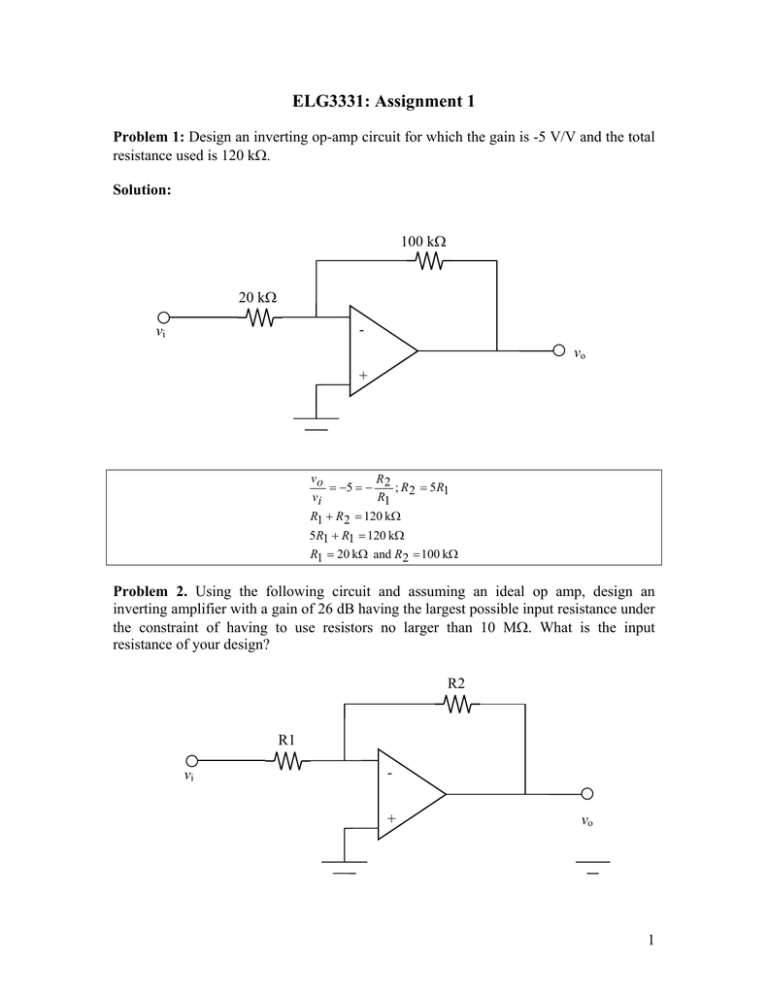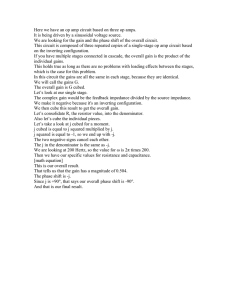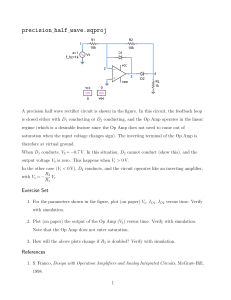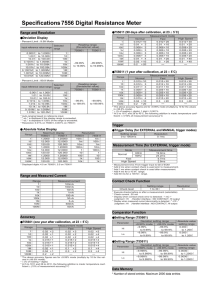ELG3331: Assignment 1
advertisement

ELG3331: Assignment 1 Problem 1: Design an inverting op-amp circuit for which the gain is -5 V/V and the total resistance used is 120 kΩ. Solution: 100 kΩ 20 kΩ - vi vo + vo R = −5 = − 2 ; R 2 = 5R1 vi R1 R1 + R 2 = 120 kΩ 5R1 + R1 = 120 kΩ R1 = 20 kΩ and R 2 = 100 kΩ Problem 2. Using the following circuit and assuming an ideal op amp, design an inverting amplifier with a gain of 26 dB having the largest possible input resistance under the constraint of having to use resistors no larger than 10 MΩ. What is the input resistance of your design? R2 R1 vi + vo 1 20 log G = 26dB G = −19.95 V/V vo R =− 2 vi R R 2 = 19.95 R1 For largest possible input resistance, select R 2 = 10 MΩ and R1 = 500 kΩ Rin = 500 kΩ Problem 3. (a) Design an inverting amplifier with a closed-loop gain of -100 V/V and an input resistance of 1 kΩ. (b) If the op amp is known to have an open-loop gain of 1000 V/V, what do you expect the closed loop gain of your circuit to be? (c) Give the value of a resistor you can place in parallel (shunt) with R1 to restore the closed loop gain to its nominal value. R2 R1 v1 vi - vo + (a ) v0 R R = − 2 ⇒ −100 v = − 2 ⇒ R2 = 100kΩ v vi R1 1kΩ v (b) A = 1000 v ⇒ v1 = − 0 v A v -v v -v v Q i 0 = 1 o ⇒ o = R1 R2 vi R2 R1 R (1 + 2 ) R1 1+ A − (c) Assume R "1 = R x || R1 when R1 = 1kΩ = - 100 = −90.8 v v 101 1+ 100 vo = −100 v v vi − vo v − o − RR Rx vi - v 0 v1 - vo vo 1 − 0 .1 100 1000 = ⇒ ⇒ R '1 = R2 × ⇒ R '1 = = 0.899kΩ = 1 x = − vo 1.001 R1 + R x 1 + R x R1 R2 vi − vo 1000 ⇒ R x = 8.9kΩ ≅ 8.87 kΩ ± 1% Problem 4. An inverting op amp circuit using an ideal op amp must be designed to have a gain of -1000 V/V using resistors no larger than 100 kΩ. 2 (a) For the simple two resistor circuit, what input resistance would result? (b) If a T-network is used as feedback circuit for the inverting amplifier with three resistors of maximum value, what input resistance results? What is the value of the smallest resistor needed? R2 R1 = 1000 R 2 = 100kΩ ⇒ R1 = 100Ω (a ) Rin = R1 = 100Ω (b) vo R R R4 = − 2 (1 + 4 + ) = −1000 vi R1 R2 R3 If R2 = R1 = R4 = 100kΩ ⇒ R3 = 100kΩ ≈ 100Ω 1000 − 2 ⇒ Rin = R1 = 100kΩ Problem 5. Consider a low pass active filter. Derive its transfer function, its DC gain and the 3-dB frequency. Design the circuit to obtain an input resistance of 1 kΩ, a DC gain of 20 dB, and a 3-dB frequency of 4 kHz. At what frequency does the magnitude of the transfer function reduce to unity? Refer to fig. P2.119 R2 1 vo R1 Z y R1 =− 2 =− 1 =− =− 1 1 + sCR 2 vi Z1 y2 + sC R2 R 1 which is an STC LP circuit with a dc gain of − 2 and 3 - dB frequency ω 0 = R1 R2 C The input resistance equal to R1 so for Ri = 1k ⇒ R1 = 1kΩ and for dc gain of 20dB or less ⇒ R2 = 10 ⇒ R 2 = 10kΩ R1 For 3dB frequency of 4 kHz : ω 0 = 2π × 4 × 10 3 = 1 ⇒ C = 4nF CR 2 The unity gain frequency is 0 dB is 40kHz. 3





